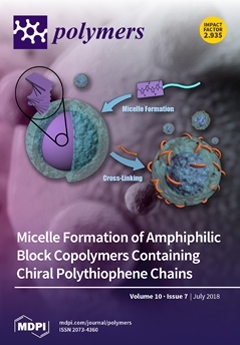Establishing the relationship among the composition, structure and property of the associated materials at the molecular level is of great significance to the rational design of high-performance electrical insulating Epoxy Resin (EP) and its composites. In this paper, the molecular models of pure
[...] Read more.
Establishing the relationship among the composition, structure and property of the associated materials at the molecular level is of great significance to the rational design of high-performance electrical insulating Epoxy Resin (EP) and its composites. In this paper, the molecular models of pure Diglycidyl Ether of Bisphenol A resin/Methyltetrahydrophthalic Anhydride (DGEBA/MTHPA) and their nanocomposites containing nano-SiO
2 with different particle sizes were constructed. The effects of nano-SiO
2 dopants and the crosslinked structure on the micro-structure and thermomechanical properties were investigated using molecular dynamics simulations. The results show that the increase of crosslinking density enhances the thermal and mechanical properties of pure EP and EP nanocomposites. In addition, doping nano-SiO
2 particles into EP can effectively improve the properties, as well, and the effectiveness is closely related to the particle size of nano-SiO
2. Moreover, the results indicate that the glass transition temperature (
Tg) value increases with the decreasing particle size. Compared with pure EP, the
Tg value of the 6.5 Å composite model increases by 6.68%. On the contrary, the variation of the Coefficient of Thermal Expansion (CTE) in the glassy state demonstrates the opposite trend compared with
Tg. The CTE of the 10 Å composite model is the lowest, which is 7.70% less than that of pure EP. The mechanical properties first increase and then decrease with the decreasing particle size. Both the Young’s modulus and shear modulus reach the maximum value at 7.6 Å, with noticeable increases by 12.60% and 8.72%, respectively compared to the pure EP. In addition, the thermal and mechanical properties are closely related to the Fraction of Free Volume (
FFV) and Mean Squared Displacement (
MSD). The crosslinking process and the nano-SiO
2 doping reduce the
FFV and
MSD value in the model, resulting in better thermal and mechanical properties.
Full article






